Imagine that, laden with weapons and equipment, you climb a steep cliff as high as a ten-story building. A strong enemy is shooting at you from the top. In addition, you are aware that it is up to you to decide on the success of the world's largest landing operation and the fate of thousands of soldiers. Difficult? Quite impossible? And yet doable!
I thought you were trying to scare me Lt. Col. James Rudder said to General Omar Bradley when the latter informed him about the task his squad was assigned. During Operation Overlord, the American 2nd Ranger Battalion was commanded by Rudder to land at the foot of a 30-meter rock, climb it and destroy the coastal gun battery.
A hard nut to crack
Perched on the high cliff of Pointe du Hoc, the German battery of six heavy guns was a real problem for the Allied planners. It is equipped with 155 mm cannons with a range of over 16,000. meters could strike targets on both Omaha Beach and Utah Beach with their fire. Moreover, they posed a lethal threat to the ships of the invasion fleet. And there were to be too many targets for the German artillerymen on day "D" ...
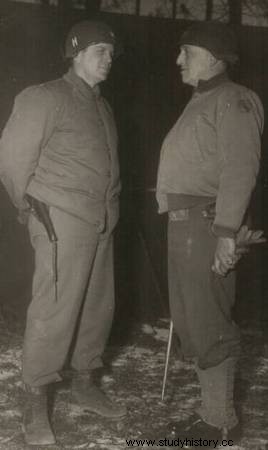
James Rudder (left), he was in charge of the rangers who were given an almost suicide mission to capture the Pointe du Hoc. In the photo with General Norman Cota.
The Allied command did not know how to neutralize them. Aerial bombardment was out of the question because, according to intelligence, the cannons were housed in bomb-proof concrete bunkers.
In addition, a massive and repeated air attack on this point of the French coast could be a clue for the Germans as to the place of the invasion.
A parachute or glider landing was also removed, as any landing sites around the battery were covered with minefields and anti-landing obstacles.
Commandos on the ladder
There was only one possibility:an attack from the sea. And the Germans did not expect this completely. From this side, the battery was defended only by a few machine gun positions. The size of the German forces was estimated at 200 soldiers.
The Rangers first conducted training on the Isle of Wight in preparation for the attack. They learned to throw on the rocks hooked ropes fired from mortars. In addition, they used lightweight, portable, folding ladders and developed an unusual "patent". Namely, they mounted long, extendable ladders on DUKW's floating transporters, borrowed from London firefighters.
Attack
At dawn on June 6, the Allied air force struck the battery, dropping more than 600 tons of bombs. Subsequently, the battleship Texas opened fire, firing approximately 250 missiles. Pointe du Hoc now resembled the cratered surface of the Moon. Around 4.00 225 soldiers from D, E and F companies of the 2nd Ranger Battalion, under the personal command of Lt. Rudder, overloaded from transports to landing craft.
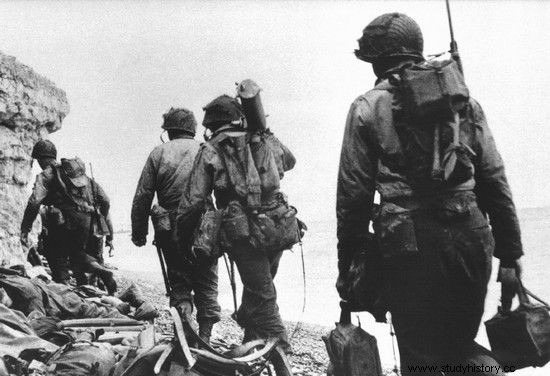
The Rangers prepare to storm Pointe du Hoc. They had to climb 30 meters high cliffs. And all this is under the murderous fire of the German defenders.
The climb to the shore was very difficult. It was completely dark. The sea was stormy. The current was also taking its toll. In these difficult navigational conditions, the British barge pilot got lost and steered the flotilla towards the headland about 5 km from the actual landing site.
Fortunately, Lt. Col. Rudder corrected the course, but while maneuvering, the units came under heavy German fire. Two amphibians and one landing barge sank. The first soldiers of the 2nd Battalion were killed. The first Rangers landed at the foot of Pointe du Hoc around 7.05. More than 40 minutes later than expected.
The delay was so disastrous that the remaining companies of the 2nd Battalion and the entire 5th Ranger Battalion, intended to support Rudder's soldiers in the event of a successful landing, did not receive the agreed signal and were unloaded on the "Omaha" beach. Lt. Col. James Rudder was left alone with three, already heavily exhausted companies. So far 40 people have lost their lives.
It's called uphill!
Nevertheless, the Americans were determined to fulfill the task. However, they were now under heavy German fire. Difficulties piled up. DUKW amphibians with fire ladders were unable to climb to the foot of the rock due to the enormous number of bomb and missile hoppers. These fired lines were wet, making them heavier and shorter range than expected.
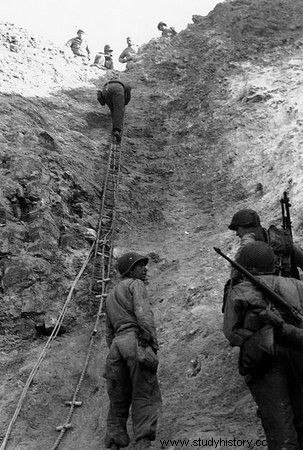
Rangers are storming Pointe du Hoc.
The Rangers still had fold-out ladders, and some started climbing with their bare hands, without any protection.
One of DUKW unfolded the ladder and from its top Sgt. William Stivison was firing a machine gun at the enemy, trying to protect his companions laboriously ascending to the top. The destroyer USS Satterlee also approached the shore and successfully offended the Germans with the fire of its guns.
Where are the goddamn cannons?
The first Rangers reached the top of the cliff 5 minutes after landing. Within half an hour the others joined. What did the Yanks see at the top?
At the edge of the cliff there was a large bunker from which the Germans fiercely fired at the Americans. The German cannon positions, destroyed by bombing, were also quickly located, but to the consternation of American soldiers, there were no cannons there, only burnt-out remains of telephone poles imitating barrels!
This article has more than one page. Please select another one below to continue reading.Attention! You are not on the first page of the article. If you want to read from the beginning click here.
Wasting no time, the Rangers split into patrols and set off inland, hoping to find some trace of the missing cannons. As they moved on, they encountered fortified German posts. There were several skirmishes in which seven Americans were killed and eight injured. The Rangers also put up fortified positions. Their task was to block the route of a possible German attack towards the captured Pointe du Hoc and the "Omaha" beach.
We have them!
Meanwhile, one of the patrols found mysterious deep ruts in the ground. Intrigued, the soldiers, Sergeants Leonard Lomell and Jack Kuhn, followed the trail between the dense, tall hedges. Leonard Lomell recalled:
Jack Kuhn and I started down this sunken road, not knowing where the hell was leading except inland. We hit a valley or a line of shrubs. We looked behind the hedge and, kneel down nations, for there were cannons behind them. (...) All of them were placed in textbook combat positions, ammunition arranged nicely, all ready, but directed towards Utah beach, not Omaha .
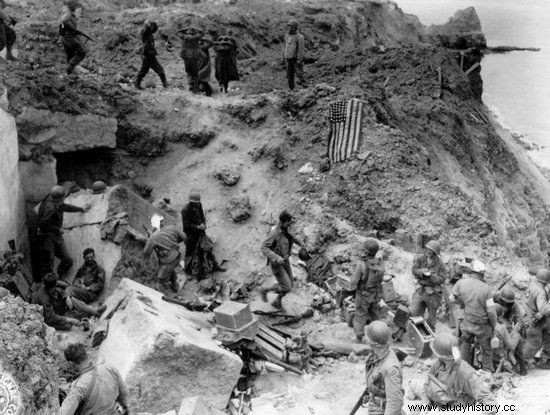
Rangers and captured German defenders of Pointe du Hoc.
It was the five guns of the wanted German battery. There was also a military vehicle nearby and a German officer conferring with his soldiers. Lomell didn't think long and was shielded by Kuhn with special thermite grenades and destroyed the barrel lifting and rotation mechanisms of two guns, then smashed the sights of all five with his Thompson butt.
In the meantime, another patrol arrived from the other side, consisting of four soldiers under the command of Sgt. Frank Rupinsky. They stumbled upon the sixth cannon with a missile in the castle chamber. In this case, the termite grenade went into the barrel. The cannon was rendered useless. On top of that, the main artillery ammunition depot was found and after a while a huge explosion struck the area. The job was done.
Praise the Lord!
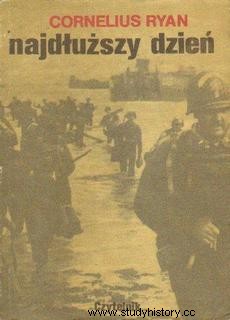
Information about the finding and destruction of the battery reached the command post of Lt. Ruddera around 9.00 a.m. Rudder immediately ordered a radio message to be sent to headquarters with the slogan "Praise the Lord".
This meant that the mission's goal was accomplished. To be sure, the communications officer also sent a carrier pigeon, also with a report with the same content.
Although the sleepy battery of the Allied staffers was destroyed, it was by no means the end of the fighting for the 2nd Ranger Battalion. The unit, thinned to 100 people, broken into small groups, got involved in heavy fighting and was surrounded by considerable German forces.
The Rangers fought off several counterattacks, and Lt. Col. Rudder sent desperate reports of a shortage of ammunition and supplies. Nevertheless, the relief came only in the morning of June 8, and it was then that the battle for Pointe du Hoc was over. The price of success was the 135 fallen soldiers of the 2nd Battalion. Thanks to this sacrifice, thousands of their colleagues on the beaches of "Utah" and "Omaha" probably owed them their salvation.
Editor:Krzysztof Chaba; Photo edition:Rafał Kuzak
